CROSS INDUSTRY PROCESS
CL ASSIFICATION FRAMEWORK®
Version 7.2.1
OVERVIEW
Cross Industry Process Classification
Framework® (PCF) is a taxonomy of cross-
functional business processes intended
to allow the objective comparison of
organizational performance within and among
organizations. The PCF was developed by
APQC and its member companies as an open
standard to facilitate improvement through
process management and benchmarking,
regardless of industry, size, or location. The
PCF organizes operating and management
processes into 13 enterprise-level categories,
including process groups and more than 1,000
processes and associated activities. The PCF,
its associated measures, and definitions are
available for download at no charge at www.
apqc.org/pcf.
OPERATING PROCESSES
1.0
Develop
Vision
and
Strategy
> > >
2.0
> > >
Develop and
Manage Products
and Services
3.0
Market
and Sell
> > >
4.0
Deliver
> > >
Physical Products
5.0
Deliver
Services
> > >
Products and
Services
6.0
Manage
Customer
Service
MANAGEMENT AND SUPPORT SERVICES
7.0 Develop and Manage Human Capital
8.0 Manage Information Technology
9.0 Manage Financial Resources
10.0 Acquire, Construct, and Manage Assets
11.0 Manage Enterprise Risk, Compliance, Remediation, and Resiliency
12.0 Manage External Relationships
13.0 Develop and Manage Business Capabilities
THE FRAMEWORK FOR
PROCESS IMPROVEMENT
Experience shows that the potential of benchmarking to drive dramatic improvement lies squarely in making out-of-the-box
comparisons and searching for insights not typically found within intra-industry paradigms. To enable this beneficial benchmarking,
the APQC Process Classification Framework (PCF)® serves as a high-level, industry-neutral enterprise process model that allows
organizations to see their business processes from a cross-industry viewpoint. The cross-industry framework has experienced more
than 20 years of creative use by thousands of organizations worldwide. The PCF provides the foundation for APQC’s Open Standards
Benchmarking® (OSB) database and the work of its advisory council of global industry leaders. Each version of the PCF will continue
to be enhanced as the OSB database further develops definitions, processes, and measures. The PCF and associated measures and
benchmarking surveys are available for download from the Open Standards Benchmarking web site at www.apqc.org/osb.
HISTORY
The cross-industry Process Classification Framework® was originally envisioned as a taxonomy of business processes and a common
language through which APQC member organizations could benchmark their processes. The initial design involved APQC and more
than 80 organizations with a strong interest in advancing the use of benchmarking in the United States and worldwide. Since its
inception in 1992, the PCF has seen updates to most of its content. These updates keep the framework current with the ways that
organizations do business around the world. In 2014, APQC worked to enhance the cross-industry PCF and updated a number of
industry-specific process classification frameworks.
The PCF is written in United States English language format.
Version 7.2.1-en-XI • September 2018
1
�
PROCESS CLASSIFICATION FRAMEWORK®
TABLE OF CONTENTS
LOOKING FORWARD
The cross-industry and industry Process Classification
Frameworks are evolving models, which APQC will continue
to enhance and improve regularly. Thus, APQC encourages
comments, suggestions, and more importantly, the sharing of
insights from having applied the PCF within your organization.
Share your suggestions and experiences with the PCF by
e-mailing pcf_feedback@apqc.org.
ABOUT APQC
An internationally recognized resource for process and
performance improvement, APQC helps organizations adapt to
rapidly changing environments, build new and better ways to
work, and succeed in a competitive marketplace. With a focus
on productivity, knowledge management, benchmarking, and
quality improvement initiatives, APQC works with its member
organizations to identify best practices; discover effective
methods of improvement; broadly disseminate findings; and
connect individuals with one another and the knowledge,
training, and tools they need to succeed. Founded in 1977, APQC
is a member-based non profit serving organizations around the
world in all sectors of business, education, and government.
APQC is also a proud winner of the 2003, 2004, 2008, 2012, and
2013 North American Most Admired Knowledge Enterprises
(MAKE) awards. This award is based on a study by Teleos, a
European-based research firm, and the KNOW network.
PROCESS CLASSIFICATION FRAMEWORK®
TABLE OF CONTENTS
Content Organization
PCF Levels Explained/Number Scheming
1.0
2.0
3.0
4.0
5.0
6.0
7.0
8.0
9.0
10.0
11.0
12.0
13.0
Develop Vision and Strategy
Develop and Manage Products and Services
Market and Sell Products and Services
Deliver Physical Products
Deliver Services
Manage Customer Service
Develop and Manage Human Capital
Manage Information Technology (IT)
Manage Financial Resources
Acquire, Construct, and Manage Assets
Manage Enterprise Risk, Compliance, Remediation, and Resiliency
Manage External Relationships
Develop and Manage Business Capabilities
3
3
4
6
8
11
13
14
16
18
23
26
27
28
29
COPYRIGHT AND ATTRIBUTION
©2018 APQC. ALL RIGHTS RESERVED. This Process Classification Framework® (“PCF”) is the copyrighted intellectual property of APQC. APQC
encourages the wide distribution, discussion, and use of the PCF for classifying and defining organizational processes. Accordingly, APQC hereby
grants you a perpetual, worldwide, royalty-free license to use, copy, publish, modify, and create derivative works of the PCF, provided that all copies
of the PCF and any derivative works contain the following attribution:
This APQC Process Classification Framework® (“PCF”) is an open standard developed by APQC, a nonprofit that promotes benchmarking and best practices
worldwide. The PCF is intended to facilitate organizational improvement through process management and benchmarking, regardless of industry, size, or geography.
To download the full PCF or industry-specific versions of the PCF, as well as associated measures and benchmarking, please visit www.apqc.org/pcf.
2
Permission granted to photocopy for personal use. ©2018 APQC. ALL RIGHTS RESERVED.
�
PCF LEVELS EXPLAINED
PROCESS ELEMENT NUMBERING SCHEME
The PCF identifies each process element using a unique 5-digit reference number following the name of the process element.[i.e., (16437),
(17060), (17061) (16458), (18129), shown in the above graphic]. This number will always refer to the conceptual definition of the process
element. The actual process elements and actual definition may change, but conceptually the decomposition will remain consistent
considering the entire scope of the PCF. A new 5-digit number will be assigned to a process element if its definition substantially changes.
Version 7.2.1-en-XI • September 2018
3
�
1.0 Develop Vision and Strategy (10002)
1.1 Define the business concept and long-term vision (17040)
extended enterprise (18083)
1.1.1 Assess the external environment (10017)
1.2.2.2
Identify competitors (19945)
Analyze and evaluate competition (10021)
Identify economic trends (10022)
Identify political and regulatory issues (10023)
Assess new technology innovations (10024)
Analyze demographics (10025)
Identify social and cultural changes (10026)
Identify ecological concerns (10027)
Identify intellectual property concerns (16790)
1.1.1.1
1.1.1.2
1.1.1.3
1.1.1.4
1.1.1.5
1.1.1.6
1.1.1.7
1.1.1.8
1.1.1.9
1.1.1.10 Evaluate IP acquisition options (16791)
1.1.2 Survey market and determine customer needs and wants
(10018)
1.1.2.1
1.1.2.2
1.1.2.3
Conduct qualitative/quantitative research and
assessments (10028)
Capture customer needs and wants (19946)
Assess customer needs and wants (19947)
1.1.3 Assess the internal environment (10019)
1.1.3.1
1.1.3.2
1.1.3.3
1.1.3.4
1.1.3.5
1.1.3.6
Analyze organizational characteristics (10030)
Analyze internal operations (19948)
Create baselines for current processes (10031)
Analyze systems and technology (10032)
Analyze financial health (10033)
Identify core competencies (10034)
1.1.4 Establish strategic vision (10020)
1.1.4.1
1.1.4.2
1.1.4.3
Define the strategic vision (19949)
Align stakeholders around strategic vision (10035)
Communicate strategic vision to stakeholders
(10036)
1.1.5 Conduct organization restructuring opportunities (16792)
1.1.5.1
1.1.5.2
1.1.5.3
Identify restructuring opportunities (16793)
Perform due-diligence (16794)
Analyze deal options (16795)
1.1.5.3.1 Evaluate acquisition options (16796)
1.1.5.3.2 Evaluate merger options (16797)
1.1.5.3.3 Evaluate de-merger options (16798)
1.1.5.3.4 Evaluate divesture options (16799)
1.2 Develop business strategy (10015)
1.2.1 Develop overall mission statement (10037)
Define current business (10044)
Formulate mission (10045)
Communicate mission (10046)
1.2.1.1
1.2.1.2
1.2.1.3
1.2.2 Define and evaluate strategic options to achieve the
objectives (10038)
1.2.2.1
Define strategic options (10047)
1.2.2.1.1 Select partnerships and
Assess and analyze impact of each option (10048)
1.2.2.2.1
Identify implications for key
operating model business elements
that require change (13289)
Identify implications for key
technology aspects (13290)
1.2.2.2.2
1.2.2.3
Develop B2B strategy (16800)
1.2.2.3.1 Develop service as a product
strategy (16801)
1.2.2.4
1.2.2.5
1.2.2.6
Develop B2C strategy (16802)
Develop partner/alliance strategy (16803)
Develop merger/demerger/acquisition/exit
strategy (16805)
Develop innovation strategy (16806)
1.2.2.7
Develop sustainability strategy (14189)
1.2.2.8
1.2.2.9
Develop global support strategy (19950)
1.2.2.10 Develop shared services strategy (19951)
1.2.2.11 Develop lean/continuous improvement strategy
(14197)
1.2.2.12 Develop innovation strategy and framework
(19952)
1.2.3 Select long-term business strategy (10039)
1.2.4 Coordinate and align functional and process strategies
(10040)
1.2.5 Create organizational design (10041)
1.2.5.1
1.2.5.2
1.2.5.3
1.2.5.4
1.2.5.5
1.2.5.6
1.2.5.7
Evaluate breadth and depth of organizational
structure (10049)
Perform job-specific roles mapping and value-
added analyses (10050)
Develop role activity diagrams to assess hand-
off activity (10051)
Perform organization redesign workshops
(10052)
Design the relationships between
organizational units (10053)
Develop role analysis and activity diagrams for
key processes (10054)
Assess organizational implication of feasible
alternatives (10055)
1.2.5.8 Migrate to new organization (10056)
1.2.6 Develop and set organizational goals (10042)
1.2.7
Identify organizational goals (19953)
Establish baseline metrics (19954)
1.2.6.1
1.2.6.2
1.2.6.3 Monitor performance against goals (19955)
Formulate business unit strategies (10043)
1.2.7.1
1.2.7.2
Analyze business unit strategies (19956)
Identify core competency for each business unit
(19957)
Refine business unit strategies in support of
relationships to support the
1.2.7.3
4
Permission granted to photocopy for personal use. ©2018 APQC. ALL RIGHTS RESERVED.
�
company strategy (19958)
1.2.8 Develop customer experience strategy (19959)
Assess customer experience (19960)
1.2.8.1.1
1.2.8.1
Identify and review customer
touchpoints (19961)
1.2.8.1.2 Assess customer experience across
touchpoints (19962)
1.2.8.1.3 Perform root cause analysis of
problematic customer experiences
(19963)
Design customer experience (19964)
1.2.8.2.1 Define and manage personas (16612)
1.2.8.2.2 Create customer journey maps (19965)
1.2.8.2.3 Define single view of the customer
for the organization (19966)
1.2.8.2.4 Define a vision for the customer
experience (19967)
1.2.8.2.5 Validate with customers (19968)
1.2.8.2.6 Align experience with brand values
and business strategies (19969)
1.2.8.2.7 Develop content strategy (19970)
Design customer experience support structure
(19971)
1.2.8.3.1
1.2.8.3.2
Identify required capabilities (19972)
Identify impact on functional
processes (19973)
1.2.8.2
1.2.8.3
1.2.8.4
Develop customer experience roadmap to develop
and implement defined capabilities (19974)
1.2.9 Communicate strategies internally and externally (18916)
1.3 Execute and measure strategic initiatives (10016)
1.3.1 Develop strategic initiatives (10057)
1.3.1.1
1.3.1.2
Identify strategic priorities (19975)
Develop strategic initiatives based on business/
customer value (19976)
1.3.1.3
Review with stakeholders (19977)
1.3.2 Evaluate strategic initiatives (10058)
1.3.2.1
Determine business value for each strategic
priority (19978)
Determine the customer value for each
strategic priority (19979)
1.3.3 Select strategic initiatives (10059)
1.3.2.2
1.3.3.1
1.3.3.2
Prioritize strategic initiatives (19980)
Communicate strategic initiatives to business
units and stakeholders (19981)
1.3.4 Establish high-level measures (10060)
1.3.4.1
1.3.4.2
Identify business value drivers (19982)
Establish baselines for business value drivers
(19983)
1.3.4.3 Monitor performance against baselines (19984)
1.3.5 Execute strategic initiatives (19507)
1.4 Develop and maintain business models (20944)
1.4.1 Develop business models (20945)
1.4.1.1
1.4.1.2
1.4.1.3
1.4.1.4
Assemble business model information (20946)
Secure appropriate approvals (20947)
Identify integration points with existing models
(20948)
Adopt the business model (20949)
1.4.2 Maintain business models (20950)
1.4.2.1
1.4.2.2
1.4.2.3
1.4.2.4
Establish business model maintenance
parameters (20951)
Accept business model feedback parameters
(20952)
Prioritize and manage incoming feedback
(20953)
Update existing models (20954)
1.4.3 Establish business model governance (20955)
Version 7.2.1-en-XI • September 2018
5
�
2.0 Develop and Manage Products and Services (10003)
2.1 Govern and manage product/service development program
(19696)
2.1.1 Manage product and service portfolio (10061)
2.1.1.1
2.1.1.2
2.1.1.3
2.1.1.4
2.1.1.5
2.1.1.6
Evaluate performance of existing products/
services against market opportunities (10063)
Confirm alignment of product/service concepts
with business strategy (10066)
Prioritize and select new product/service
concepts (10074)
Plan and develop cost and quality targets (10073)
Specify development timing targets (10075)
Plan for product/service offering modifications
(10076)
2.1.2 Manage product and service life cycle (10067)
2.1.2.1
2.1.2.2
2.1.2.3
2.1.2.4
2.1.2.5
Develop plan for new product/service
development and introduction/launch (16824)
Introduce new products/services (10077)
Retire outdated products/services (10078)
Identify and refine performance indicators
(10079)
Conduct post launch review (11423)
2.1.2.5.1 Carry out post launch analytics to test
the acceptability in the market (19646)
2.1.2.5.2 Review market performance (11424)
2.1.2.5.3 Review effectiveness of supply
chain and distribution network
(11425)
2.1.2.5.4 Apply data and analytics to review
supply chain methodologies (19647)
2.1.2.5.5 Review quality and performance of
the product/service (11426)
2.1.2.5.6 Conduct financial review (11427)
2.1.2.5.7 Conduct new product development
process assessment (11428)
2.1.3 Manage patents, copyrights, and regulatory requirements
(19985)
2.1.3.1
2.1.3.2
2.1.3.3
2.1.3.4
Conduct mandatory and elective reviews
(19941)
Review infringement of patents and copyrights
(16826)
Determine patent and copyright needs (16827)
Define product technical documentation
management requirements (19697)
2.1.3.5 Manage regulatory requirements (12771)
2.1.3.5.1 Train employees on appropriate
regulatory requirements (12772)
2.1.3.5.2 Maintain records for regulatory
agencies (12773)
2.1.3.5.3 Manage regulatory submission life
cycle (12776)
2.1.4 Manage product and service master data (11740)
2.1.4.1 Manage materials master lists (11741)
2.1.4.2 Manage bills of material (11742)
2.1.4.3 Manage routings (11743)
2.1.4.4 Manage specifications (11744)
2.1.4.5 Manage drawings (11745)
2.1.4.6 Manage product/material classification (11746)
2.1.4.7
Develop and maintain quality/inspection
documents (11747)
2.1.4.8 Maintain process specification data (11748)
2.1.4.9 Manage traceability data (11749)
2.1.4.10 Review and approve data access requests
(11750)
2.2 Generate and define new product/service ideas (19698)
2.2.1 Perform discovery research (10065)
2.2.1.1
2.2.1.2
2.2.1.3
Identify new technologies (10070)
Develop new technologies (10071)
Assess feasibility of integrating new leading
technologies into product/service concepts
(10072)
2.2.2.2
2.2.2.3
2.2.2.1
2.2.2 Generate new product/service concepts (19669)
Gather new product/service ideas and
requirements (19986)
Analyze new product/service ideas and
requirements (19987)
Evaluate new product/service inputs and
requirements (19988)
Formulate new product/service concepts
(19989)
Identify potential improvements to existing
products and services (10068)
2.2.2.5
2.2.2.4
2.2.3 Define product/service development requirements (19990)
2.2.3.1
Define product/service requirements (11331)
2.2.3.1.1 Define basic functional requirements
(19991)
2.2.3.1.2 Derive interoperability requirements
for products and services (16808)
2.2.3.1.3 Derive safety requirements for
products and services (16809)
2.2.3.1.4 Derive security requirements for
products and services (16810)
2.2.3.1.5 Derive regulatory compliance
requirements (16811)
2.2.3.1.6 Derive requirements from industry
standards (16812)
2.2.3.1.7 Develop user experience
requirements (19992)
2.2.3.1.8 Derive ‘services-as-a-product’
offering (16814)
2.2.3.2
2.2.3.3
Define post launch support model (16815)
Identify product/service bundling opportunities
(17389)
6
Permission granted to photocopy for personal use. ©2018 APQC. ALL RIGHTS RESERVED.
�
2.3 Develop products and services (10062)
2.3.1 Design and prototype products and services (19993)
2.3.1.1
2.3.1.2
2.3.1.3
2.3.1.4
2.3.1.5
2.3.1.6
2.3.1.7
2.3.1.8
2.3.1.9
Assign resources to product/service project
(10083)
2.3.1.1.1
Identify requirements for product/
service design/development partners
(19994)
Prepare high-level business case and technical
assessment (10084)
Develop product/service design specifications
(10085)
Develop user experience design specifications
(16813)
Provide warranty-related recommendations
(16817)
Document design specifications (10086)
Conduct mandatory and elective external
reviews (10087)
Design products/services (19995)
2.3.1.8.1 Design for manufacturing (16819)
2.3.1.8.2 Design for product servicing (16820)
2.3.1.8.3 Design for re-manufacturing (16821)
2.3.1.8.4 Review product troubleshooting
methodology (16822)
2.3.1.8.5 Design and manage product data,
design, and bill of materials (16818)
2.3.1.8.6 Design for product upgrades (16823)
Build prototypes/proof of concepts (10088)
2.3.1.10 Develop and test prototype production and/or
service delivery process (10098)
2.3.1.11 Eliminate quality and reliability problems
(10089)
2.3.1.12 Conduct in-house product/service testing and
2.3.1.13
evaluate feasibility (10090)
Identify design/development performance
indicators (10091)
2.3.1.14 Collaborate on design with suppliers and
external partners (10092)
2.3.2 Test market for new or revised products and services
(19996)
2.3.2.1
2.3.2.2
2.3.2.3
2.3.2.4
Prepare detailed market study (10093)
Conduct customer tests and interviews (10094)
Finalize product/service characteristics and
business cases (10095)
Finalize technical requirements (10096)
2.3.3 Prepare for production/service delivery (19997)
2.3.3.1
2.3.3.2
2.3.3.3
2.3.3.4
Design and obtain necessary capabilities/
materials and equipment (10099)
Identify requirements for changes to
manufacturing/delivery processes (10097)
Request engineering/process change (11418)
Install and validate production/service delivery
process (10100)
2.3.3.4.1 Monitor initial production runs
(11417)
2.3.3.5
Validate launch procedures (19998)
Version 7.2.1-en-XI • September 2018
7
�
3.0 Market and Sell Products and Services (10004)
3.1 Understand markets, customers, and capabilities (10101)
3.1.1 Perform customer and market intelligence analysis (10106)
Conduct customer and market research (10108)
3.1.1.1.1 Understand consumer needs
3.1.1.1
and predict customer purchasing
behavior (10114)
3.1.1.2
Identify market segments (10109)
3.1.1.2.1 Determine market share gain/loss
(10115)
3.1.1.3
3.1.1.4
3.1.1.5
3.1.1.6
Analyze market and industry trends (10110)
Analyze competing organizations, competitive/
substitute products/services (10111)
Evaluate existing products/services (10112)
Assess internal and external business
environment (10113)
3.1.2 Evaluate and prioritize market opportunities (10107)
3.1.2.1
3.1.2.2
3.1.2.3
3.1.2.4
Quantify market opportunities (10116)
Determine target segments (10117)
3.1.2.2.1
Identify under-served and saturated
market segments (18941)
Prioritize opportunities consistent with
capabilities and overall business strategy
(10118)
Validate opportunities (10119)
3.1.2.4.1
Test with customers/consumers
(10120)
3.1.2.4.2 Confirm internal capabilities (10121)
3.2 Develop marketing strategy (10102)
3.2.1 Define offering and customer value proposition (11168)
3.2.1.1
3.2.1.2
3.2.1.3
3.2.1.4
Define offering and positioning (11169)
Develop value proposition including brand
positioning for target segments (11170)
Validate value proposition with target segments
(11171)
Develop new branding (11172)
3.2.2 Define pricing strategy (10123)
3.2.2.1
3.2.2.2
3.2.2.3
3.2.2.4
Conduct pricing analysis (13169)
Establish guidelines for applying pricing and
discounting of products/services (10124)
Establish pricing targets (19999)
Approve pricing strategies/policies and targets (10125)
3.2.3 Define and manage channel strategy (20000)
3.2.3.1
3.2.3.2
3.2.3.3
3.2.3.4
3.2.3.5
3.2.3.6
Determine channels to be supported (20001)
Establish channel objectives (20002)
Determine channel role and fit with target
segments (10127)
Select channels for target segments (10128)
Identify required channel capabilities (20003)
Evaluate channel attributes and potential
3.2.3.7
partners (10126)
Orchestrate seamless customer experience
across supported channels (20004)
3.2.3.7.1 Define omni-channel strategy
(16590)
3.2.3.7.2 Define omni-channel requirements
(16591)
3.2.3.7.3 Develop omni-channel policies and
procedures (16592)
3.2.3.8
Develop and manage execution roadmap
(20005)
3.2.4 Analyze and manage channel performance (20006)
3.2.4.1
Establish channel-specific metrics and targets
(16573)
3.2.4.2 Monitor and report performance (16574)
3.2.4.3 Monitor and report events influencing factors
(16575)
Analyze performance (16500)
Develop plan for improvements (16501)
3.2.5 Develop marketing communication strategy (16848)
3.2.4.4
3.2.4.5
3.2.5.1
3.2.5.2
3.2.5.3
3.2.5.4
3.2.5.5
3.2.5.6
3.2.5.7
3.2.5.8
Develop customer communication calendar
(16849)
Define public relations (PR) strategy (16850)
Define direct marketing strategy (16851)
Define internal marketing communication
strategy (16852)
Identify new media for marketing
communication (16853)
Define new media communication strategy
(16854)
Define point of sale (POS) communication
strategy (16855)
Define communication guidelines and
mechanisms (18627)
3.2.6 Design and manage customer loyalty program (18924)
3.2.6.1
3.2.6.2
3.2.6.3
Define customer loyalty program (20007)
Acquire members to customer loyalty program
(18925)
Build engagement and relationship with
members (18926)
3.2.6.4 Monitor customer loyalty program benefits to
3.2.6.5
the enterprise and the customer (16633)
Optimize loyalty program value to both the
enterprise and the customer (18927)
3.3 Develop and manage marketing plans (20008)
3.3.1
Establish goals, objectives, and metrics for products/
services by channel/segment (10148)
3.3.2 Establish marketing budgets (10149)
3.3.2.1
Confirm marketing alignment to business
strategy (10155)
8
Permission granted to photocopy for personal use. ©2018 APQC. ALL RIGHTS RESERVED.
�

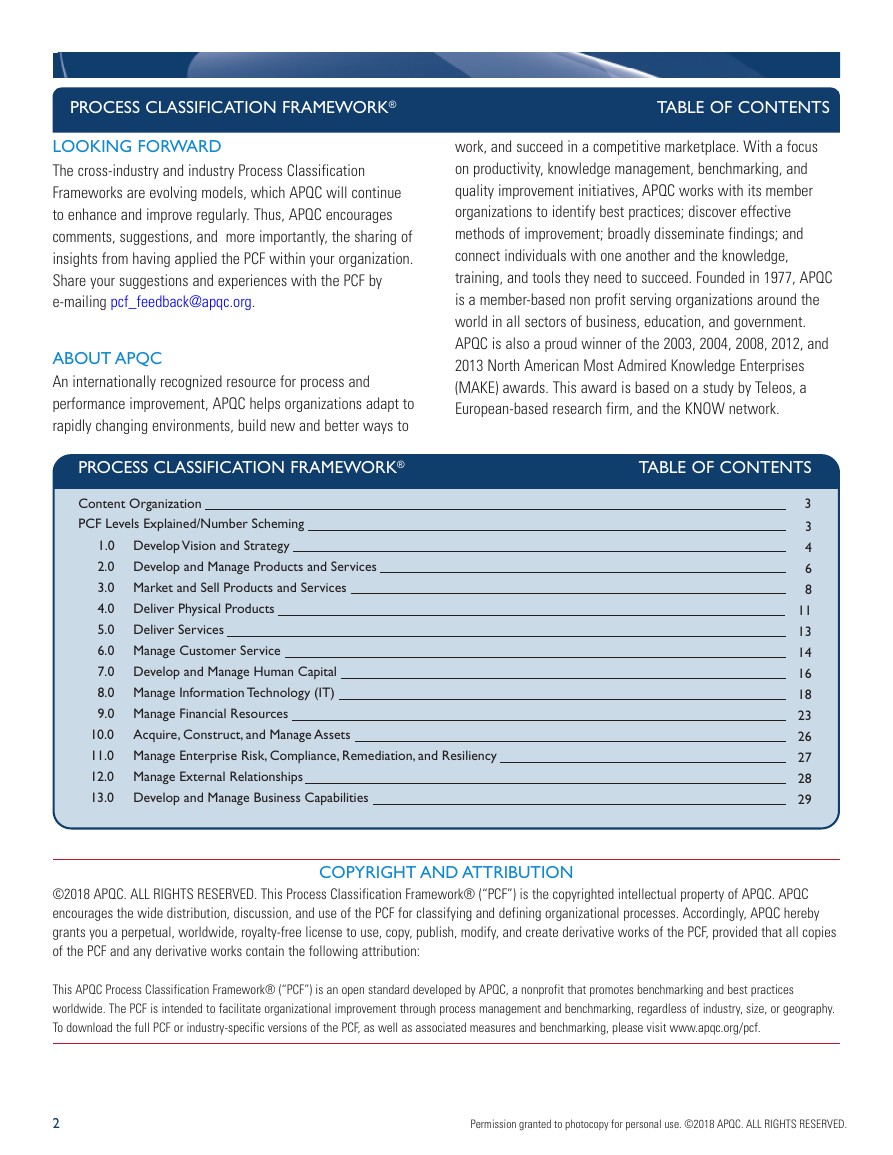
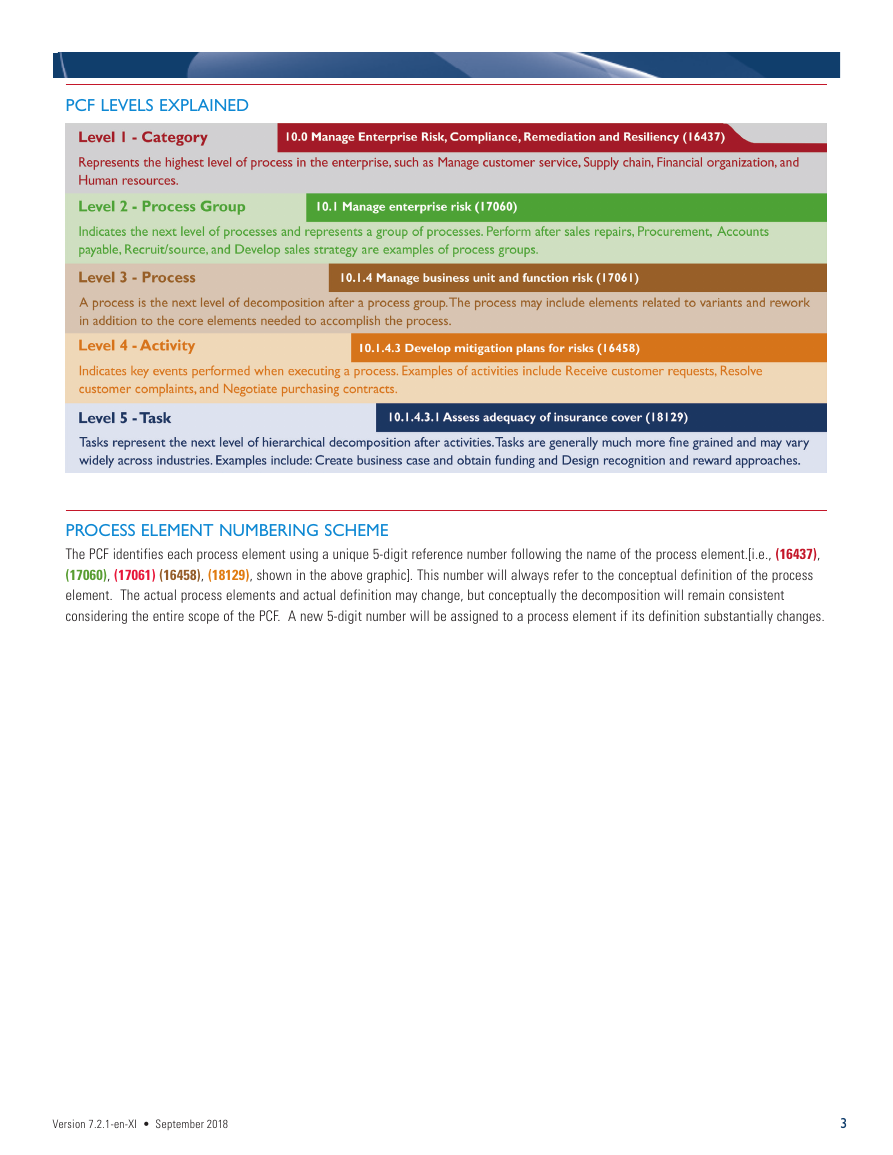
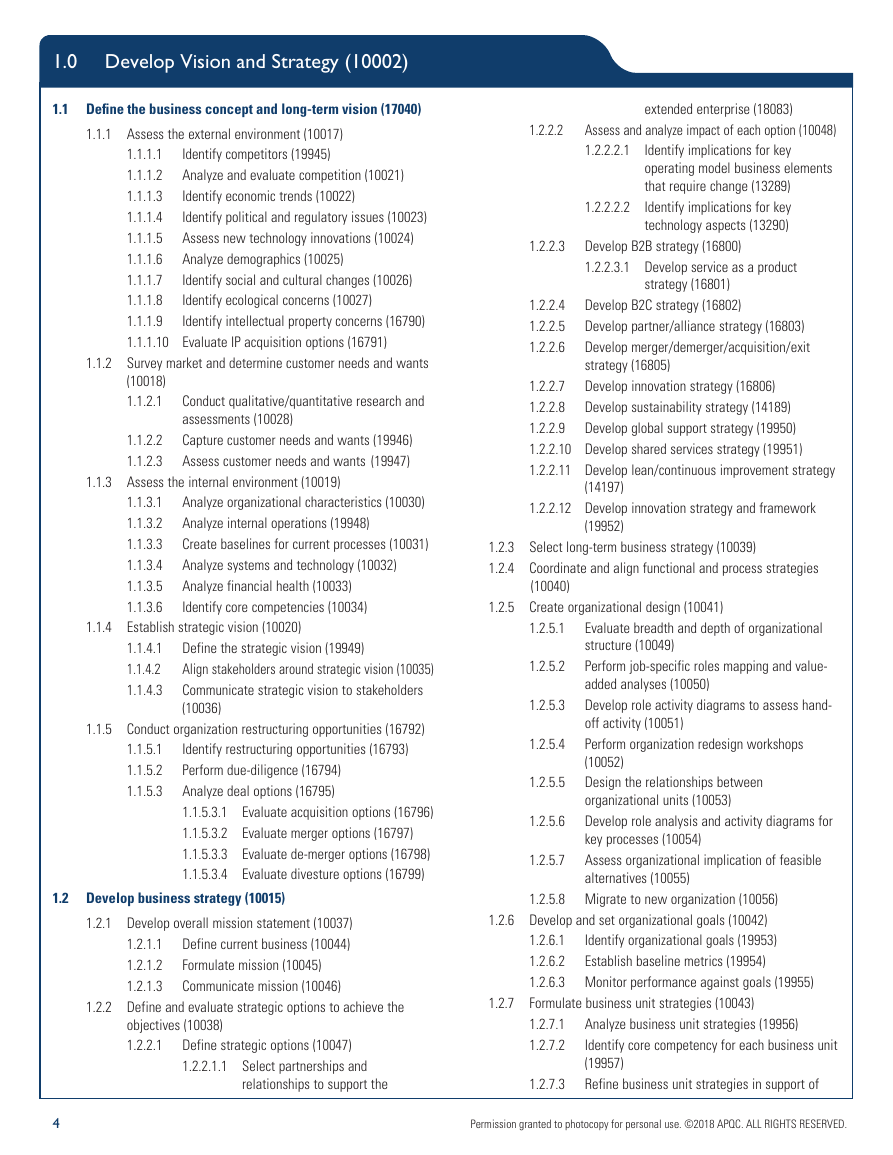
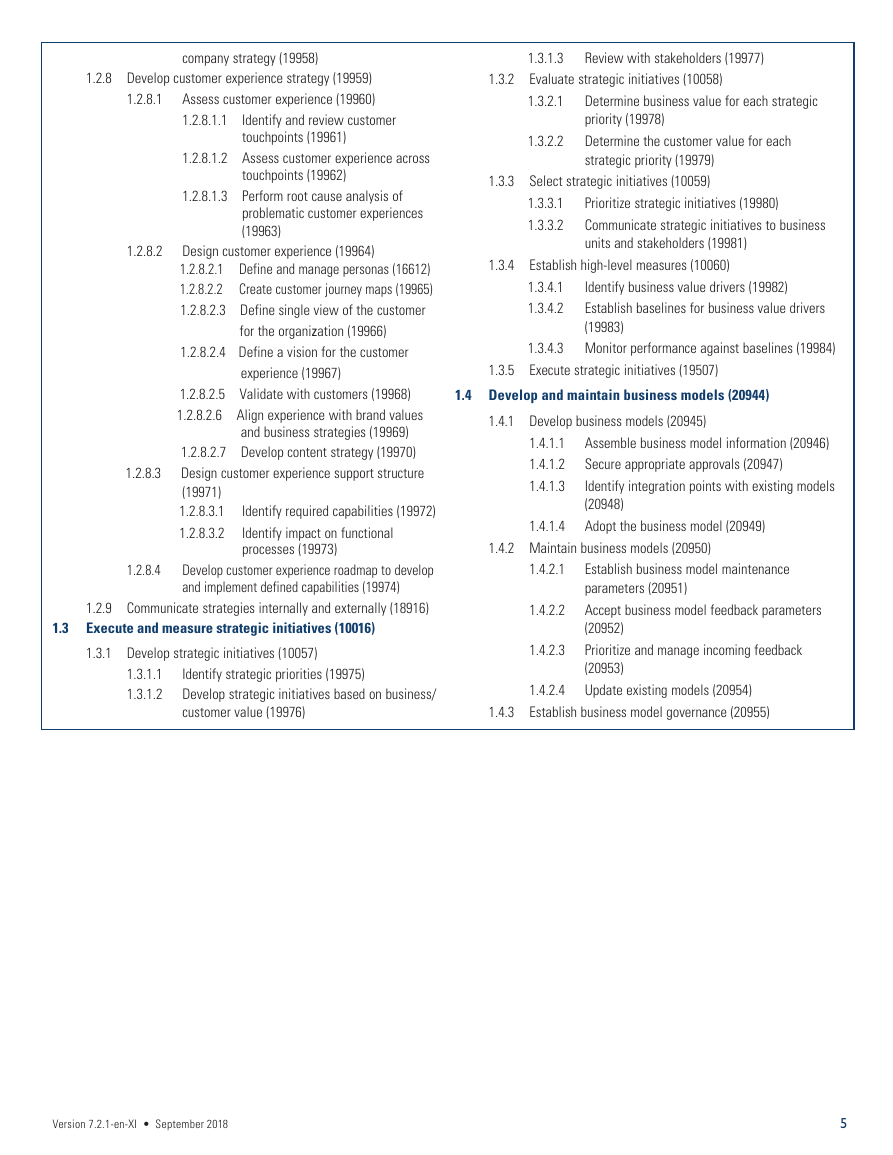
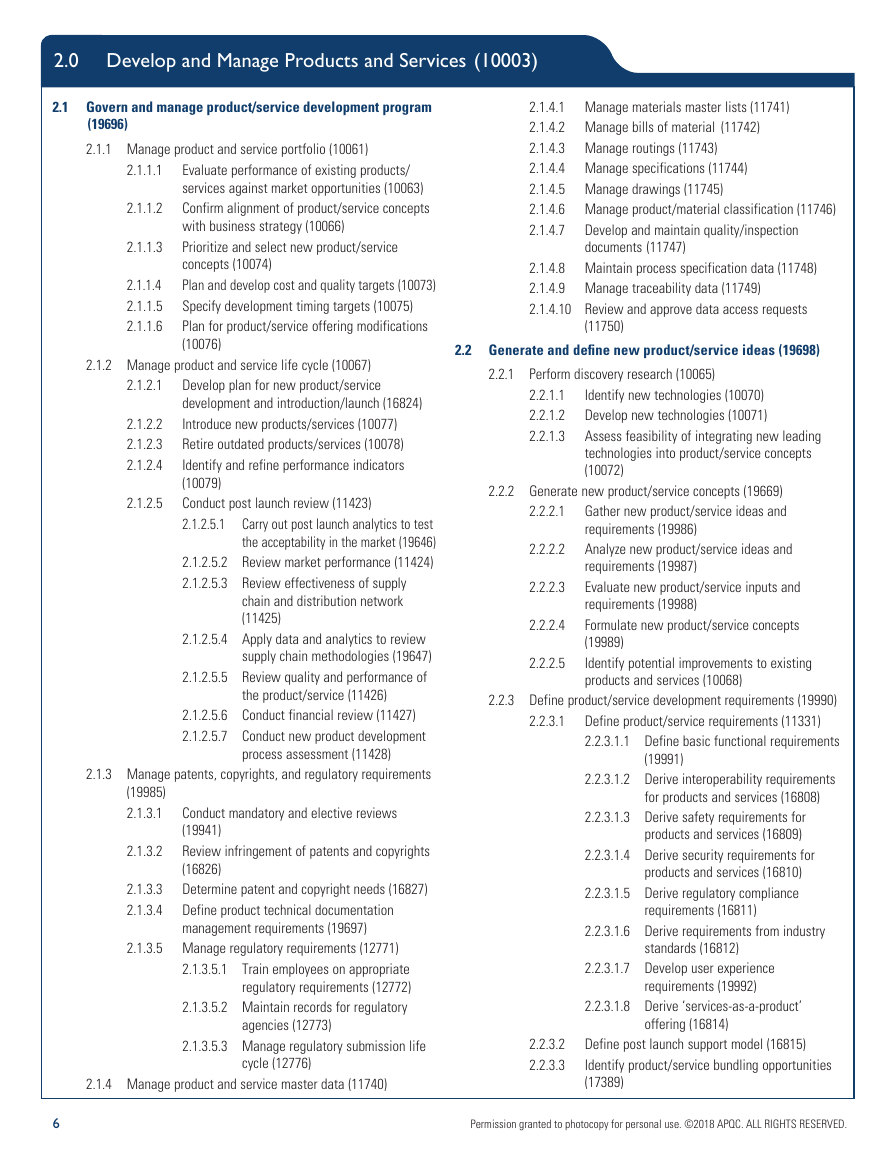
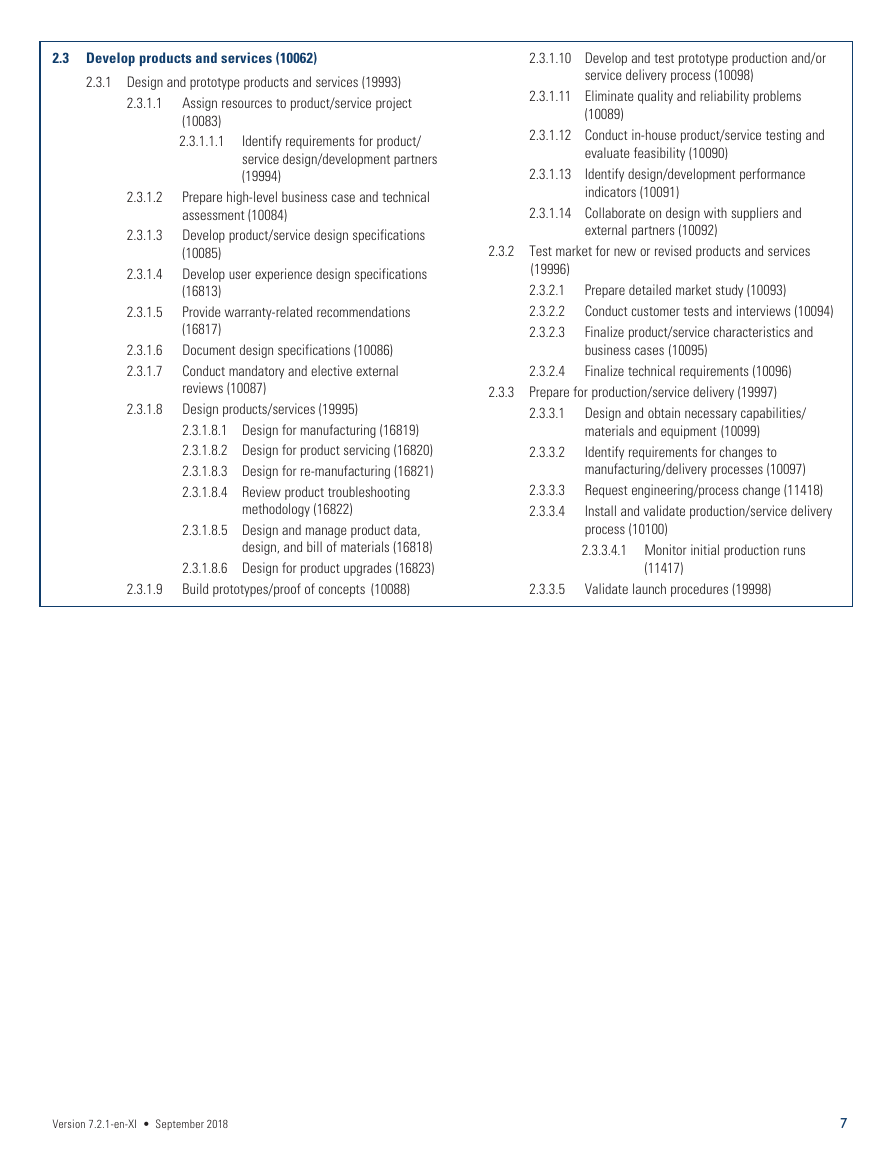
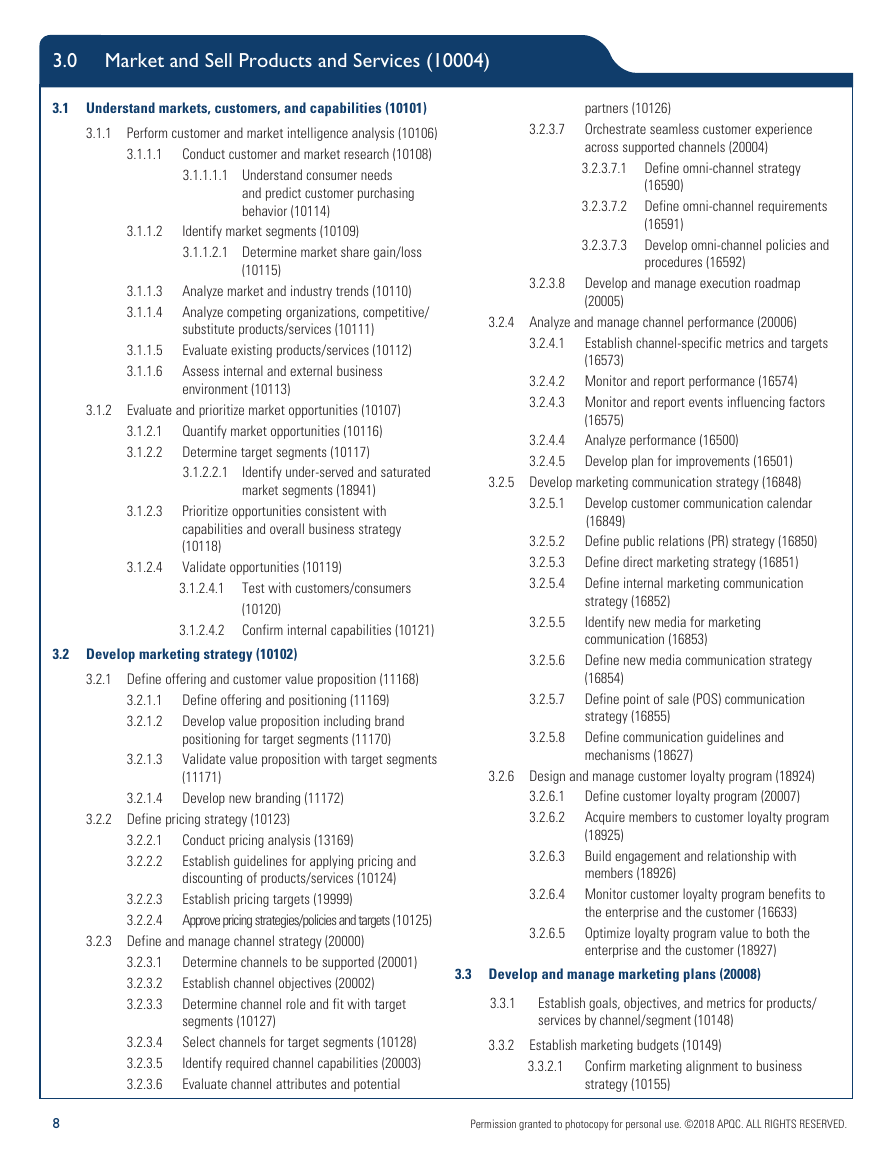








 2023年江西萍乡中考道德与法治真题及答案.doc
2023年江西萍乡中考道德与法治真题及答案.doc 2012年重庆南川中考生物真题及答案.doc
2012年重庆南川中考生物真题及答案.doc 2013年江西师范大学地理学综合及文艺理论基础考研真题.doc
2013年江西师范大学地理学综合及文艺理论基础考研真题.doc 2020年四川甘孜小升初语文真题及答案I卷.doc
2020年四川甘孜小升初语文真题及答案I卷.doc 2020年注册岩土工程师专业基础考试真题及答案.doc
2020年注册岩土工程师专业基础考试真题及答案.doc 2023-2024学年福建省厦门市九年级上学期数学月考试题及答案.doc
2023-2024学年福建省厦门市九年级上学期数学月考试题及答案.doc 2021-2022学年辽宁省沈阳市大东区九年级上学期语文期末试题及答案.doc
2021-2022学年辽宁省沈阳市大东区九年级上学期语文期末试题及答案.doc 2022-2023学年北京东城区初三第一学期物理期末试卷及答案.doc
2022-2023学年北京东城区初三第一学期物理期末试卷及答案.doc 2018上半年江西教师资格初中地理学科知识与教学能力真题及答案.doc
2018上半年江西教师资格初中地理学科知识与教学能力真题及答案.doc 2012年河北国家公务员申论考试真题及答案-省级.doc
2012年河北国家公务员申论考试真题及答案-省级.doc 2020-2021学年江苏省扬州市江都区邵樊片九年级上学期数学第一次质量检测试题及答案.doc
2020-2021学年江苏省扬州市江都区邵樊片九年级上学期数学第一次质量检测试题及答案.doc 2022下半年黑龙江教师资格证中学综合素质真题及答案.doc
2022下半年黑龙江教师资格证中学综合素质真题及答案.doc